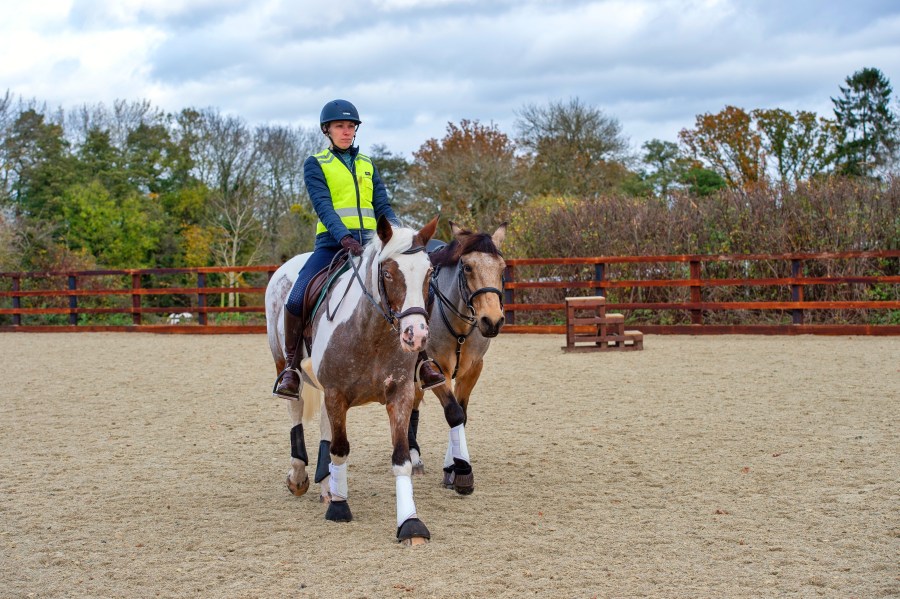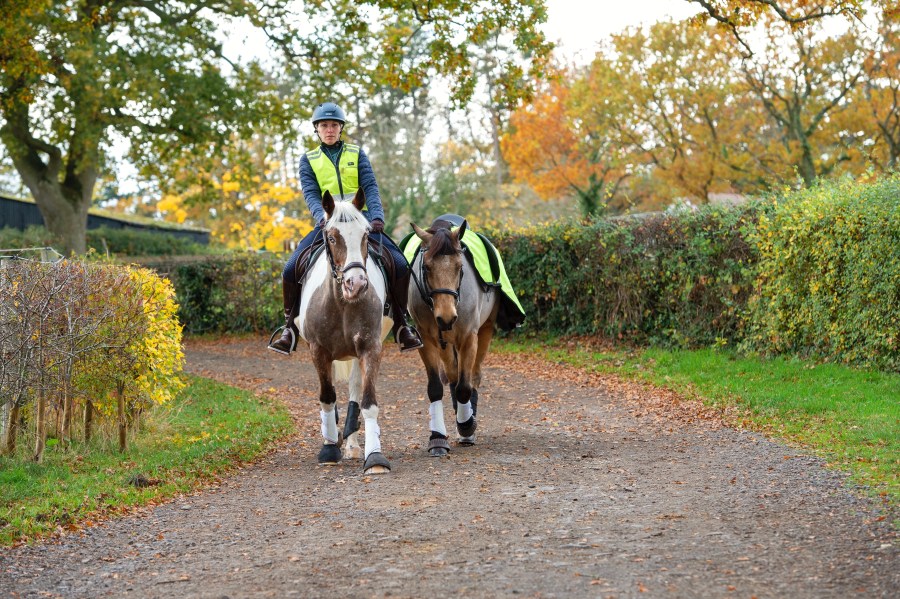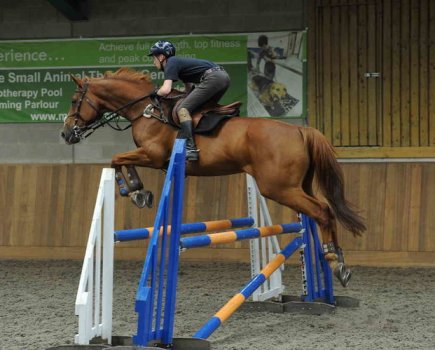Sometimes there just aren’t enough hours in the day to ride more than one horse or pony and so it becomes necessary to ride one and lead another out hacking at the same time.
This is also a good way to exercise a child’s pony during school hours that is too small for you to ride, or perhaps you’re bringing a horse back into work slowly or waiting for a saddle to be fitted.
Maybe you have a retired horse that is no longer ridden but could do with a leg stretch or you’re trying to get two horses fit at the same time.
There are myriad reasons why it’s so useful to be able to ride and lead — but it’s a skill that needs to be learned and practised.
“At a big yard I managed, it was rare for us to hack with only one horse — we had so many to exercise that if you were hacking, you had at least two horses, if not more,” says yard manager and former polo groom Robyn Cherry.
“That went for hunters, liveries, polo ponies, everything.
“Being a groom, it’s hard fitting in your own horses around work, so when I’m short of time, but want to get them out for a good long ride, I take them together by riding one and leading one.
“I use it for young horses too, to get them out seeing the world, with the steadying influence of an older, more experienced horse at their side.”
Suitable horses
A horse that is good to lead from the ground is more likely to be suitable for leading off another horse.
Ride and lead is also easier if you’re on a pair of horses that get on.
Generally, a horse that kicks or gets nervous about having another horse in close proximity is unlikely to be easy to lead off — and they may not be suitable to lead either.
Common sense applies too.
Don’t lead off a horse who is nappy or who can be spooky in traffic if you’re going to be on the road.
Also consider whether it’s a good idea to take two strong, excitable horses out together if you’re going to be in open fields. Spoiler: it probably isn’t.
Safety should always come first — yours, the horses, and any members of the public you might meet while you’re out hacking.
Bridle, not headcollar
Always have a bridle on the horse you’re leading rather than a headcollar, as it will give you more control.
“Some people use a lead rope, but I prefer reins,” says Robyn.
“I was taught to loop the reins through the offside bit ring to give you a little more control and to prevent them getting looped around the horse’s nose.”
If you do opt for a lead rope, make sure it is attached to the outside bit ring and threaded through the inside bit ring. This will give you a better contact with your lead horse.
Make sure the rope is long enough and that the horse you’re on is steady.
You must also be confident riding and steering with one hand before you attempt leading another horse.
Lead horse’s position
“The key when leading is to keep the lead horse’s head at your knee,” advises Robyn.
“If the horse you’re leading gets ahead of you, that is where you can start to lose control or have problems with the horses racing each other.
“Also ensure the reins aren’t looped around your hand, and that you aren’t leaving lots of slack to get caught around your boot or stirrup.”
If, on the other hand, the lead horse drags behind, try a change of pace to trot to enthuse them.
Longer term, teaching them to respond to voice cues is vital for this. It’s tricky to carry and use a whip if riding and leading, although it is possible.
Managing an excitable lead horse
Trotting can also help to settle a lead horse that feels spooky or excited.
Beware going any faster than this unless you’re very experienced and you know both horses very well.
You don’t want a quiet canter to turn into a race, so you mustn’t allow the lead horse’s head to go any further forward than your knee.
Hold the lead horse’s reins firmly, but never wrap them around your hand.
In the UK, we put the lead horse on the left, particularly on the road, as you have more control of the swing of a horse’s quarters if you’re sitting on it.
Horse boots
Robyn recommends putting over-reach boots on both horses.
“It’s a good idea to start with, as an inexperienced ride and leader, or inexperienced horses, can result in lost shoes if the horses tread on each other,” she explains.
“I also advise putting brushing boots on both horses for the same reason.
“If you will be on the road, wear bright clothing and hi-vis — on you and both horses — to ensure you are clearly seen.”

Learn to ride and lead
Start in an enclosed space
Practise first in a safe area, such as a small field or arena, at walk.
Practise circles, stopping, starting, and sharp turns in both directions.
Both horses need to be calm and confident around other horses as they will be in close proximity, and any scraps could put the rider in danger.
Horses that know each other and are either stabled next door or turned out together tend to ride and lead well as a pair.
Go slowly
Stay in walk until you’re confident. Then progress to trot.
Make sure you’re confident doing the same shapes and turns in trot.
Stay relaxed, keep your shoulders straight (some grooms who ride and lead a lot get back problems from twisting), and keep your left arm at your side.
Practise stopping
To stop, simply put a little pressure on the lead horse’s reins — they should stop when the ridden horse does.
Learn how to turn
When leading a horse on your left side:
- To turn left, use rein pressure to slow the lead horse a little and then turn the ridden horse across their path.
- To turn right, turn the ridden horse and gently guide the lead horse around with you using the reins.
Hand signals
The final thing to practise before going out on the roads is hand signals.
Practise holding both sets of reins in each hand, and giving signals to turn right and left, slow down, and give thanks to drivers.
If drivers don’t know what you’re doing, nobody is safe.
This comes with practice, so spend a while in the school or riding around the yard before you tackle the open road.
Getting on and off
In an ideal world, you’ll mount your ridden horse and a helper will pass you the lead rope for the lead horse. But if no such helpers are available, here’s how to do it…
- Place your mounting block where you have plenty of room, not up against a wall or in a tight corner.
- Walk both horses up to the mounting block, one on either side of you. Your ridden horse should be on your right and your lead horse should be on your left, and they should be separated by you and the mounting block, which should now be in the middle.
- Use the mounting block to get on your ridden horse as usual. The only difference is that as you put your reins into your left hand, you should now have the lead horse’s reins in your left hand too.
- At this moment, your horses should be stood almost parallel to each other with a mounting block in the middle of them.
- Once you are on, you can simply walk them both forward and away you go.
- Another method is to stand your lead horse at a right angle to you, rather than parallel, to give you room to mount your ridden horse. This can be a good method if you need to keep your horses under closer control.
When dismounting, position your lead horse at a right angle from the ridden horse so that you have room to dismount. Place both sets of reins in your left hand and dismount.







